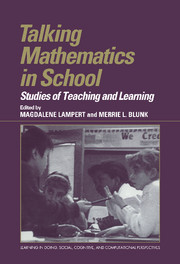Book contents
- Frontmatter
- Contents
- Series Foreword
- Acknowledgments
- List of Contributors
- 1 Introduction
- Part I Doing and Learning Mathematical Talk
- 2 Language Socialization in the Mathematics Classroom: Discourse Practices and Mathematical Thinking
- 3 The Role of Imagery and Discourse in Supporting Students' Mathematical Development
- 4 Building a Context for Mathematical Discussion
- 5 Disciplined Perception: Learning to See in Technoscience
- Part II Teaching Mathematical Talk
- Afterword
- Author Index
- Subject Index
3 - The Role of Imagery and Discourse in Supporting Students' Mathematical Development
Published online by Cambridge University Press: 04 August 2010
- Frontmatter
- Contents
- Series Foreword
- Acknowledgments
- List of Contributors
- 1 Introduction
- Part I Doing and Learning Mathematical Talk
- 2 Language Socialization in the Mathematics Classroom: Discourse Practices and Mathematical Thinking
- 3 The Role of Imagery and Discourse in Supporting Students' Mathematical Development
- 4 Building a Context for Mathematical Discussion
- 5 Disciplined Perception: Learning to See in Technoscience
- Part II Teaching Mathematical Talk
- Afterword
- Author Index
- Subject Index
Summary
The current reform movement in mathematics education places particular emphasis on the role of classroom discourse in supporting students' mathematical development. In particular, the Professional Standards for Teaching Mathematics (National Council of Teachers of Mathematics [NCTM], 1991) argue that “the nature of classroom discourse is a major influence on what students learn about mathematics” (p. 45). The teacher's role in guiding the development of productive mathematical discourse includes deciding when to allow students to struggle with an idea, when to ask questions, and when to tell. These decisions are based on the teacher's judgments about the ways individual students might be able to reorganize their thinking as they participate in communal classroom processes. In this manner, teachers can be seen to orchestrate classroom discourse based on their understandings of the mathematics they are teaching and of their students' reasoning (NCTM, 1991).
In this chapter, we focus on the relationship between discourse as a communal or collective activity and the mathematical development of students as they participate in it and contribute to its development. Our particular concern is with a process that we call the folding back of discourse, wherein the mathematical relationships under discussion are redescribed in terms of the specific situations from which they emerged. We conjecture that the participation of individual students in this collective process constitutes a supportive context for them to ground their increasingly sophisticated mathematical activity in situation-specific imagery.
Information
- Type
- Chapter
- Information
- Talking Mathematics in SchoolStudies of Teaching and Learning, pp. 56 - 81Publisher: Cambridge University PressPrint publication year: 1998
Accessibility standard: Unknown
Why this information is here
This section outlines the accessibility features of this content - including support for screen readers, full keyboard navigation and high-contrast display options. This may not be relevant for you.Accessibility Information
- 12
- Cited by
